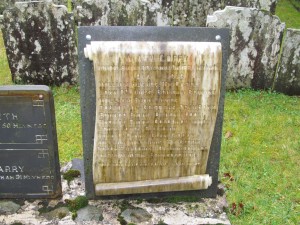WW1 Memorial in Y Tabernacl, the Welsh Baptist chapel in Cardiff
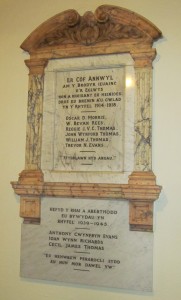 On a wall inside the Tabernacl, the Welsh Baptist chapel on the Hayes in central Cardiff, there is a memorial to the six men of the congregation who died in the Great War.
On a wall inside the Tabernacl, the Welsh Baptist chapel on the Hayes in central Cardiff, there is a memorial to the six men of the congregation who died in the Great War.
The memorial itself is impressive, being carved in marble.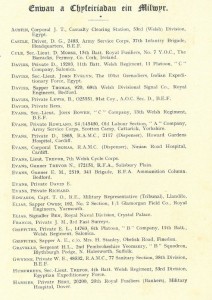
There are no records to indicate whether the chapel displayed a ‘Roll of Honour’ as the war was being fought, to highlight the contribution of a large number of the congregation to the war effort. However, the chapel’s Annual Reports do note the names of all the men who enlisted, and so we can trace how the war had a deeper effect every year on the congregation. There were 45 names on the list at the end of 1915, 62 by the end of 1916 and 66 in 1917 (including four who had been killed). The membership of the Tabernacl during the war fluctuated from around 520 to 560, so the total of 66 represents a sizeable proportion of the young male membership of the church.
List of chapel members serving in 1916
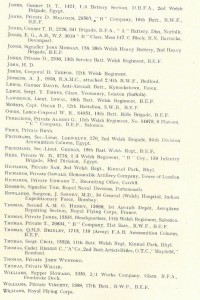
We can also see how the War’s impact became deeper and more painful from the minister’s comments in the reports. At the end of 1914 there was more discussion about the fire that had damaged the chapel than about the War, but the Rev Charles Davies’ comments became ever more emotional as the war dragged on and took an ever-increasing number of young men from his flock. Looking back upon 1916, he wrote that the young men left a large gap, and that their valuable contribution to the life of the chapel was deeply missed by those who were left. However, there is no doubt that the minister considered the war to be just, as he used such words as ‘teyrngarwch’ (loyalty), ‘dewrder’ (courage) and ‘aberth’ (sacrifice) to describe the men’s contribution to the war effort. He declared that as they faced the dangers and discomforts of the war, they were fighting ‘er amddiffyn ein gwlad, a sicrhau buddugoliaeth i gyfiawnder a gwir rhyddid yn ein byd’ (to defend our country, and to ensure a victory for justice and for the true freedom of our world).
In the lists of the men there is information about where a number of them were serving. At the end of 1916 a large number were in training camps in England or Wales; 14 with the BEF (British Expeditionary Force) on the Western Front; six in Egypt; four in Salonica and one in Bombay.
The first name on the memorial is Oscar D. Morris. It is possible to find a great deal of information about him: the letter he wrote as he sought to join the Welsh Army Corps are available on the Cymru1914 website – http://cymru1914.org/en/view/archive/4089505
One can also find a report on his promotion to lieutenant (August 1915 – http://cymru1914.org/en/view/newspaper/3886208/7/ART121) and then reports on his death on the Western Front on 21 April 1917 (http://cymru1914.org/en/view/newspaper/3886989/1/ART11 and http://cymru1914.org/en/view/newspaper/3886999/3/ART35 ). 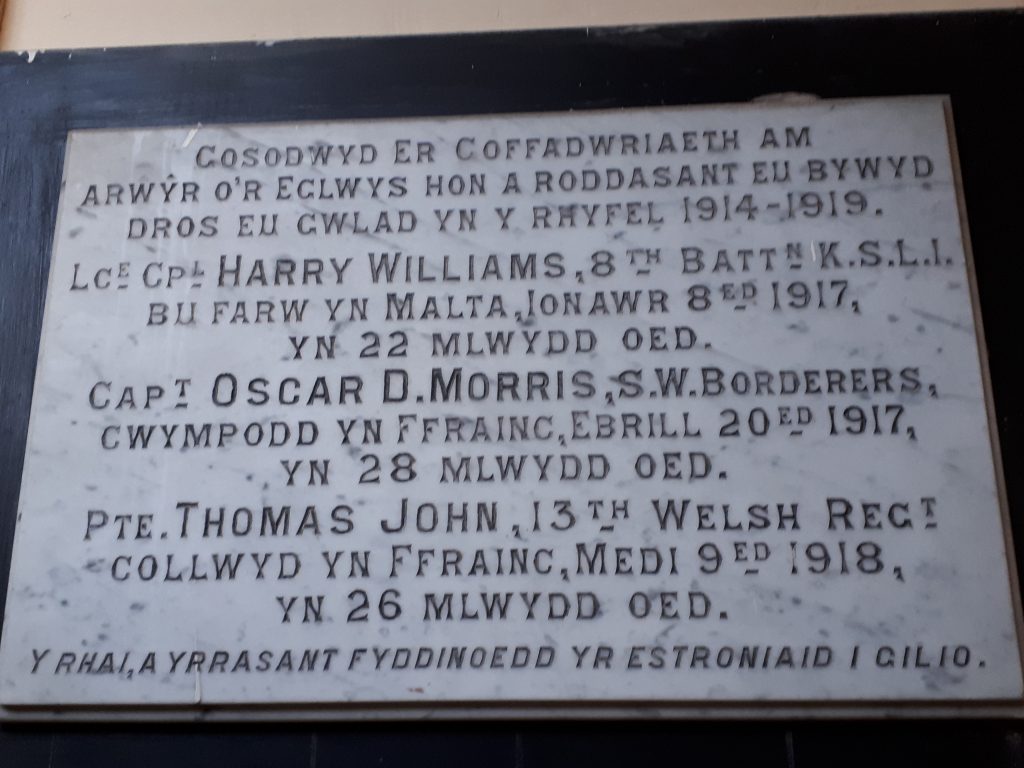
Oscar’s name is also to be found on the memorial in his home chapel – Salem Nantyffyllon.
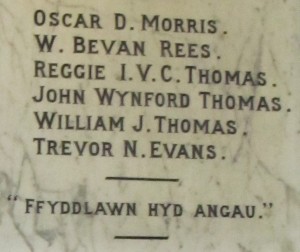 The second name is W. Bevan Rees, originally from Llandybïe, Carmarthenshire (who was 20 years old and working as a miner at the time of the 1911 census). He died in Palestine on 3 November 1917.
The second name is W. Bevan Rees, originally from Llandybïe, Carmarthenshire (who was 20 years old and working as a miner at the time of the 1911 census). He died in Palestine on 3 November 1917.
Reggie I.V.C.Thomas is the next name: he died on 24 November 1917 aged 19, while serving on the Western Front with the South Wales Borderers. He has no known grave, but his name is on the Cambrai memorial.
One can find John Wynford Thomas as a 12 year old boy in the 1911 Census, living in Lampeter Velfrey. There is no indication of when he moved to Cardiff, but he enlisted in the city, joining the South Wales Borderers. He was killed in Flanders on 31 October 1917.
Despite his common name, it is certain that the William John Thomas named on the memorial was an 18 year old who died on 11 July 1918 while serving with the Army Service Corps. He is buried in Cathays Cemetery, Cardiff.
However, the final name on the memorial is not on the list of the Commonwealth War Graves Commission. According to the Tabernacl’s records he was a soldier in 1916, serving as a Gunner with the RFA (Royal Field Artillery) on Salisbury Plain. The chapel’s report says that he died on 18 February 1919.
g.h.matthews March 22nd, 2016
Posted In: chapels / capeli, memorials, Uncategorized
Tags: chapels / capeli, memorials, WW1
Castle Steel Works, Rogerstone, War memorial
Numerous companies erected memorials to their employees who were killed in the First World War and Welsh companies, works, railways and other industrial employers are well represented in the range of known and surviving memorials.
One of the larger Welsh industrial employers of the opening decades of the twentieth century was Guest, Keen & Nettlefolds Ltd, which owned steelworks, engineering works and collieries located mainly in south east Wales. The company had been created in 1902 by the amalgamation of earlier companies, amongst them Nettlefolds Ltd, whose Birmingham factories dominated UK production of wood screws. The steel that formed Nettlefolds’ raw material was made in the company’s Castle Steelworks at Rogerstone, a short distance north west of Newport.
Castle Steel Works had opened in 1888 as the successor to an earlier iron works of the same name at Hadley near Wellington in 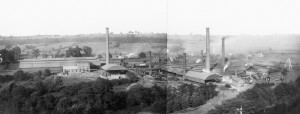 Shropshire when Nettlefolds converted from using wrought iron to using steel as the raw material for wood screw manufacture. Many of the workmen from the original Castle Works migrated to work in the new Castle Works, followed by their families. The ‘Shroppies’ secured many of the skilled jobs and formed a distinctive community within the Rogerstone area.
Shropshire when Nettlefolds converted from using wrought iron to using steel as the raw material for wood screw manufacture. Many of the workmen from the original Castle Works migrated to work in the new Castle Works, followed by their families. The ‘Shroppies’ secured many of the skilled jobs and formed a distinctive community within the Rogerstone area.
Photograph of the Castle Steel Works in 1902
Lloyd George, Minister of Munitions in the early part of the First World War, famously declared that Britain was ‘fighting a steel war’, so crucial was the availability of steel supplies to the war effort. From November 1915 most UK steelworks came under Government control, including Castle Works. In the early part of the war many steelworks reported labour shortages resulting from enthusiastic rates of volunteering. After the industry came under Government control, skilled men were mostly prevented from volunteering; after conscription began in 1916 unskilled men in essential industries, including steel, were increasingly ‘combed-out’ and conscripted.
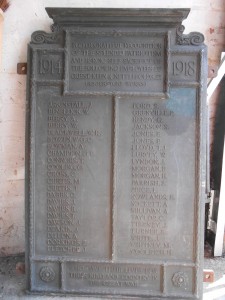 The Castle Steel Works memorial plaque lists many distinctively non-Welsh surnames and it is likely that descendants of the ‘Shroppies’ are well represented although it should also be recalled that the industrial areas of Monmouthshire experienced much emigration from Herefordshire and adjoining counties in the late nineteenth century and in the opening years of the twentieth century so not all the ‘English’ surnames necessarily originated in Shropshire.
The Castle Steel Works memorial plaque lists many distinctively non-Welsh surnames and it is likely that descendants of the ‘Shroppies’ are well represented although it should also be recalled that the industrial areas of Monmouthshire experienced much emigration from Herefordshire and adjoining counties in the late nineteenth century and in the opening years of the twentieth century so not all the ‘English’ surnames necessarily originated in Shropshire.
GKN commissioned similar bronze plaques for its other works, mines and factories. Whilst the wording (“In ever grateful recognition of the splendid patriotism and heroic self sacrifice of the following employees of Guest, Keen & Nettlefolds, Ltd.”, followed by the name of works) was consistent across all known plaques, the design of each plaque varied, especially with regard to the forms of the ornate borders and the arrangement of the fields in which the text (often divided in two), years, and lists of names were placed. There appears to have been a distinct policy of subtle variation within a broadly uniform ‘company design’. All the deceased are listed in alphabetical order by surname and forenames represented by initials.
The plaque is not inscribed with the name of the foundry that cast it. GKN possessed a number of foundries capable of producing this quality of casting and it is possible that the plaques were designed and cast in-house. It is at 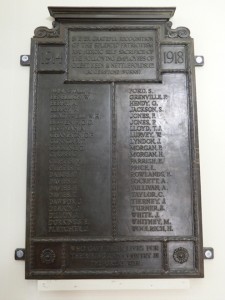 least equally likely that the plaques were commissioned from a specialist external foundry.
least equally likely that the plaques were commissioned from a specialist external foundry.
Comparison with GKN’s other sites suggests that the Castle Works plaque was probably placed in the steel works general offices. When the Rogerstone works was replaced by the third Castle Works in 1938, located in Cardiff, the plaque moved along with many of the employees. After the Cardiff works came under new ownership in 1981, the Castle Works general offices at Cardiff were demolished and the plaque was earmarked for scrap. It was saved by a private individual however and in 2015 was donated to Amgueddfa Cymru – National Museum Wales jointly by the individual and the successor company that owns Castle Works Cardiff.
Robert Protheroe Jones
Principal Curator – Industry
Department of History & Archaeology
Amgueddfa Cymru – National Museum Wales
Photographs of the memorial before and after conservation. Thanks to Amgueddfa Cymru – National Museum Wales for the images
g.h.matthews March 14th, 2016
Posted In: memorials, workplaces / gweithleoedd
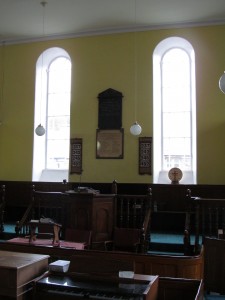 situated on the wall behind the pulpit, so that any worshipper who is looking at the minister will have the memorial in their line-of-sight.
situated on the wall behind the pulpit, so that any worshipper who is looking at the minister will have the memorial in their line-of-sight.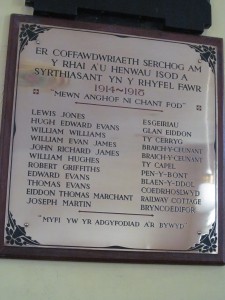 Esgeiriau
Esgeiriau